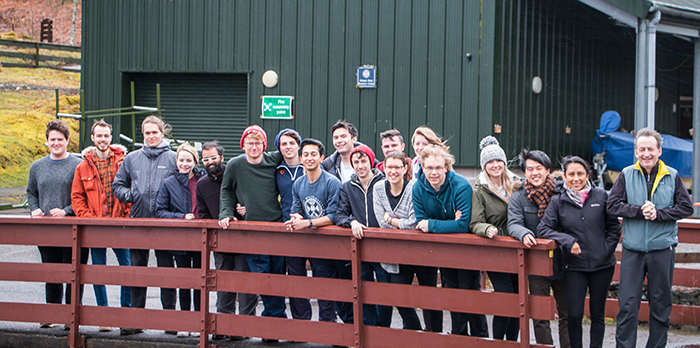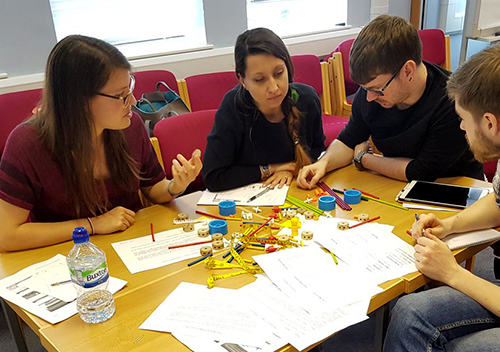
EPSRC Centre for Doctoral Training in Intelligent Sensing and Measurement
Developing expertise in the research and development of sensing devices, techniques and systems
Sensing is one of the most important things that underpins the modern economy. The devices, techniques and systems that enable us to make measurements, and collect and use data, are now fundamental to areas such as health, cities, transport, defence, communications and the environment. As a result, we need scientists and engineers who can design sensing devices and systems that enable future progress in these and other fields.
One of Glasgow's real research strengths can be found among its many scientists who have a focus on sensing and measurement. As the home of the James Watt Nanofabrication Centre (JWNC), Glasgow also boasts one of the best facilities in the UK for developing devices that perform these functions.
These qualities enabled Glasgow, in partnership with Edinburgh University, to attract funding for the EPSRC Centre for Doctoral Training in Intelligent Sensing and Measurement (CDT-ISM). Running since 2014, this provides a fully-funded 4-year Masters and PhD programme for a cohort of a dozen promising students each year.
Leading the programme is Professor Andy Harvey, Chair of Experimental Physics at Glasgow.
"What makes a sensing system? You have a device, a technique and a system. Our students get exposed to these three key components of sensing and measurement." he says.
"With devices, we have the means to make novel devices through the JWNC, so that's really quite a jewel in the crown in terms of having a national facility accessible to these students. Then we have people who do the sort of research I do, which is in developing techniques. A student developing a technique also needs to understand how the whole system of sensing works. The technique is the top-level 'how do I do it?'. The system is the device, the technology, and the processes for how that technique is implemented."
"We have a nice critical mass of about 40 possible PhD supervisors at Glasgow who work in this field." he adds.
In the first year, the students experience the broad range of research undertaken in sensing and measurement across both Glasgow and Edinburgh. Beyond this they focus on their PhD with a supervisor from either institution that suits their choice of project. Throughout the four years, they maintain a close connection with their CDT cohort through a programme of events and collaborative opportunities.
"Our students develop a good network early on." explains Professor Harvey. "At the end of the first semester they'll have a direct network of about 20 people they've dealt with. But through a network of networks they'll actually know how to access perhaps 100 people. Through this, they recognise that they don't have to be an expert in everything. They just need to understand how to access people with expertise."
There is an emphasis on working across traditional academic boundaries. While many of the students in the programme have a background in physics or engineering, many of the research projects are applied to biomedicine, diagnostics and other aspects of biology and also chemistry. Professor Harvey believes the openness to collaboration at Glasgow is a major benefit to the students in the programme.
"There's a will to collaborate here. And there's a complementarity between different research areas that invites collaboration." he says.
"I like research that involves solving problems and there are lots of people at Glasgow with the sort of problems I like to address. Many of these are in the College of Medicine, Veterinary and Life Sciences. For example, we work with people developing miniature microscopes to enable you to image biological processes in animals. One of the real developments in that particular field is the ability to accurately measure the blood oxygenation deep inside tissue - inside a small animal for instance. That is now done by fusing ultrasound with a visible technique. This demonstrates how we need to train people who understand the relative benefits of each one of those techniques."
The programme is closely aligned with industry and each student takes up a placement during the four years.
One of the partners of the CDT is CENSIS, the Innovation Centre for Sensor and Imaging Systems (SIS), focused on this industry in Scotland. Its research indicates a global market for sensor systems valued at £500Bn, a Scottish sensor systems market worth £2.6Bn pa, and over 170 sensor systems companies based in Scotland (SMEs and large companies).
"There is an advantage in having a breadth of training across sensing and measurement." says Professor Harvey. "From an industry perspective, if I have a problem, I want to solve it. What I don't want is to go to an optics person who is going to give me an optics solution. I want to go to a person who says, 'I understand all of the different ways of solving this problem using a range of sensing, that could be an electronic way, an optical way, a radiation way, and I will choose the best of those'. That's the training that our CDT provides."

Group photo of students at a DTC conference
Student profile
Two current students are Giovanna Marocco and Chiara Garbellotto, both from Italy.
Giovanna is studying for a Doctorate in Engineering and is part of the Institute for Gravitational Research. She also has a industry placement aligned to her EngD project, developing a sensor to help guide the positioning (attitude control) of a CubeSat system in relation to Earth. To do this she is partnered with Glasgow-based company ClydeSpace.
For her, the experience of both academia and industry within the programme encourages a more versatile approach in her work.
"Working with industry has different demands, it's driven by the outcome so they are focused on getting a solution that works rather than the perfect solution. It's important to experience this world and the academic world. In the academic setting I was focused on the design on my device but the industry setting pushed me towards fabricating it – getting something produced." she says.
Based in Professor Harvey's Imaging Concepts group, Chiara's research focus is on the development of new imaging and sensing techniques for fluorescence microscopy, with the ultimate aim of improving microscope imaging capabilities for biologists studying living animals. She came to the CDT with a background in astronomy, which she now applies to the development of optics for microscopy.
She feels the Masters year of the CDT was valuable for exposing students to a broad range of new concepts and approaches in sensing and measurement. This gave students the opportunity to discover new fields to apply their existing knowledge to. The first year also had a focus on building the student community, which helped everyone deal with the broad range of course material.
"In the first year you really have the time to learn things. You have people around you. You never feel really lost. Because if you don't understand something someone else will. In the end you put together everyone's different backgrounds and experience to get the group through." she says.

Chiara Garbellotto (far left) and Giovanna Marocco (2nd from left)
Funders:
Discover more:

